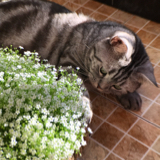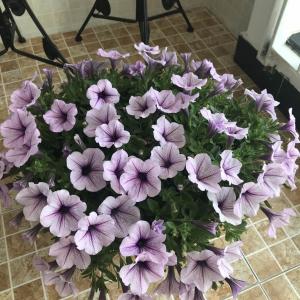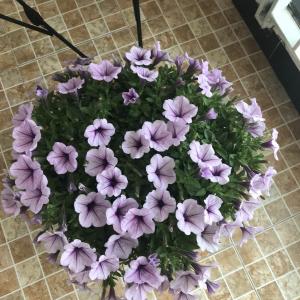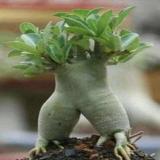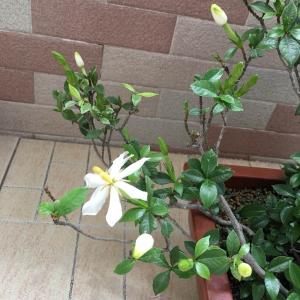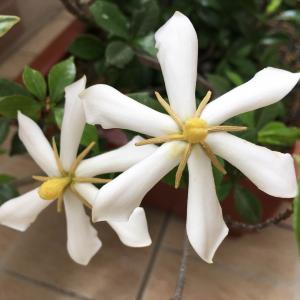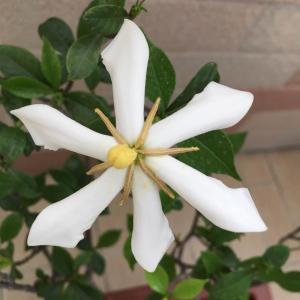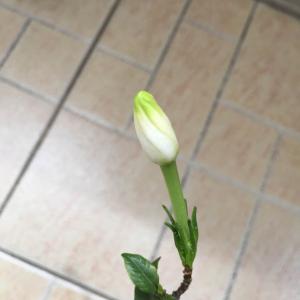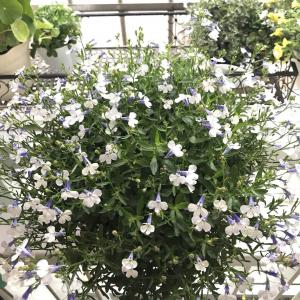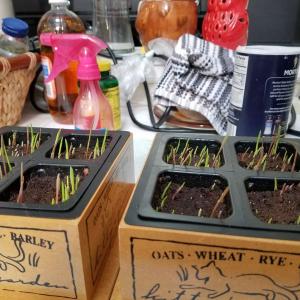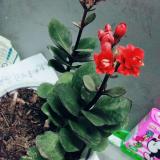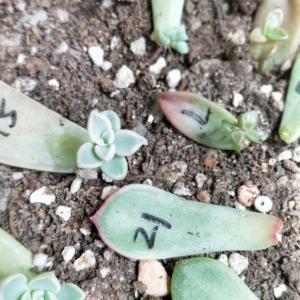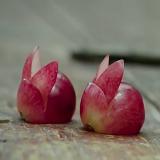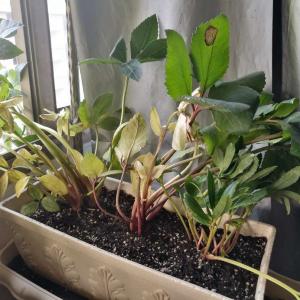文章
Miss Chen
2018年05月17日

Description: This perennial plant is about 1½–2½' tall, branching occasionally. The stems are light green and densely covered with white hairs. The alternate leaves are up to 5½" long and 2" across; they are lanceolate to ovate, smooth along the margins, and sessile. The upper surface of each leaf is dark green, sparsely covered with short hairs, and pinnately veined; the lower surface is light green and densely covered with short white hairs. The lateral veins are conspicuous on both sides of the leaves. The flowers bloom near the apex of the stems. They occur individually from the axils of the leaves; their pedicels are short. Each flower is about ¼" across, consisting of a hairy green calyx with 5 linear-lanceolate teeth and a pale yellow corolla with 5 spreading lobes and a narrow throat. The tube of the corolla is no longer than the teeth of the calyx. The reproductive organs are hidden within the corolla. The blooming period occurs from mid-spring to early summer. Only a few flowers are in bloom at the same time. They are replaced by ovoid-globoid nutlets with an outer coat that is white, smooth, and hard. The root system consists of a taproot, which may send up more than one stem.
Cultivation: The preference is dappled sunlight during the spring and light to medium shade during the remainder of the year. The soil should be moist to slightly dry, fertile and loamy, containing abundant organic matter. The hard white seeds are difficult to germinate.
Range & Habitat: The native American Gromwell is scattered across Illinois; it is an uncommon plant (see Distribution Map). Populations of this species within the state have probably declined. Habitats include rich deciduous woodlands, wooded slopes, and shaded riverbanks. This conservative species prefers high quality woodlands where the original ground flora is largely intact.
Faunal Associations: The structure of the flowers suggests that the pollinators are long-tongued bees and butterflies. More specific information about floral-faunal relationships is currently unavailable.

Photographic Location: Toward the bottom of a moist wooded slope in Vermilion County, Illinois.
Comments: American Gromwell is one of the woodland wildflowers that blooms during the spring, but it is often overlooked and many field guides fail to describe it, probably because its flowers are not very showy. American Gromwell resembles Lithospermum officinale (European Gromwell) in its overall appearance. This latter species produces flowers in flat-headed cymes and its leaves are more slender. In contrast, American Gromwell produces individual flowers from the axils of the leaves. Another European species, Buglossoides arvense (Corn Gromwell), produces individual flowers from the axils of the leaves, but these flowers are bright white and its leaves are smaller in size. Corn Gromwell produces nutlets that are brown and wrinkled, rather than smooth and white. Other Lithospermum spp. in Illinois are native prairie plants that also produce flowers in flat-headed cymes. The flowers of these latter species have longer corollas that are a brilliant yellow or orange-yellow.
Cultivation: The preference is dappled sunlight during the spring and light to medium shade during the remainder of the year. The soil should be moist to slightly dry, fertile and loamy, containing abundant organic matter. The hard white seeds are difficult to germinate.
Range & Habitat: The native American Gromwell is scattered across Illinois; it is an uncommon plant (see Distribution Map). Populations of this species within the state have probably declined. Habitats include rich deciduous woodlands, wooded slopes, and shaded riverbanks. This conservative species prefers high quality woodlands where the original ground flora is largely intact.
Faunal Associations: The structure of the flowers suggests that the pollinators are long-tongued bees and butterflies. More specific information about floral-faunal relationships is currently unavailable.

Photographic Location: Toward the bottom of a moist wooded slope in Vermilion County, Illinois.
Comments: American Gromwell is one of the woodland wildflowers that blooms during the spring, but it is often overlooked and many field guides fail to describe it, probably because its flowers are not very showy. American Gromwell resembles Lithospermum officinale (European Gromwell) in its overall appearance. This latter species produces flowers in flat-headed cymes and its leaves are more slender. In contrast, American Gromwell produces individual flowers from the axils of the leaves. Another European species, Buglossoides arvense (Corn Gromwell), produces individual flowers from the axils of the leaves, but these flowers are bright white and its leaves are smaller in size. Corn Gromwell produces nutlets that are brown and wrinkled, rather than smooth and white. Other Lithospermum spp. in Illinois are native prairie plants that also produce flowers in flat-headed cymes. The flowers of these latter species have longer corollas that are a brilliant yellow or orange-yellow.
0
0
文章
Miss Chen
2018年05月16日

Description: Depending on its stage of development, this herbaceous perennial plant is about 3-12" tall. It produces only basal leaves that are about 3-5" wide and across. Each of these basal leaves is wrapped around the stalk of a single flower (sometimes two stalks are produced) as the flower begins to bloom. The basal leaves continue to unfold to their fullest extent as the flowers wither away. Each basal leaf is oval-orbicular in outline and palmate-reticulately veined, with 5-9 major lobes and several minor lobes along the undulating margins. The palmate-reticulate venation is fairly prominent and provides the rather succulent leaves with a wrinkly appearance, especially on their lower surfaces. The color of the leaves on the upper surface is light green, sometimes with greyish or bluish tints, while the lower surface is whitish green. The terete petioles are about 4" long and rather stout. The foliage of this plant is glabrous and glaucous.
The flowering stalk is terete, stout, glabrous, and sometimes slightly reddish, terminating in a single large flower. This stalk is about 3-4" tall when the flower begins to bloom. The flower is about 1½–3" across, consisting of 8-16 white petals, a green oval pistil, and numerous stamens with prominent yellow anthers. The pistil has a pale yellow stigma at its apex. There are 2 light green sepals that are nearly as long as the petals, but they fall off the flowering stalk as soon as the flower begins to bloom. The blooming period occurs from early to mid-spring, lasting about 2 weeks. Each flower remains in bloom for only 1 or 2 days (when it is sunny), producing a fragrant scent. Afterwards, each flower is replaced by a seed capsule that becomes enlarged and eventually turns yellow, splitting open to release its seeds. The root system consists of thick reddish rhizomes with coarse fibrous roots. Both the foliage and the rhizomes contain an acrid reddish juice. This plants often forms vegetative colonies.

Cultivation: During early to mid-spring, this plant should have access to some sunlight, otherwise the flowers may fail to open. After the trees begin to form leaves later in the spring, considerable shade is tolerated. The soil should be fertile and loamy, with average moisture levels (by woodland standards). The foliage is not affected by disease significantly, although it will gradually wither away as the summer progresses.
Range & Habitat: Bloodroot is a common plant that occurs in most counties of Illinois (see Distribution Map), where it is native. Habitats include rich deciduous woodlands, wooded slopes, edges of bluffs, shaded ravines, banks of rivers in wooded areas, and areas along woodland paths.

Faunal Associations: The pollen of the flowers attracts various kinds of bees, including honeybees, bumblebees, little carpenter bees (Ceratina spp.), Halictid bees (Halictus spp., Lasioglossum spp.), and Andrenid bees (Andrena spp.). Other insects that visit the flowers include Syrphid flies and beetles, which feed on the pollen (or search vainly for nectar). An aphid, Linosiphon sanguinarium, sucks plant juices from the leaf undersides. The seeds of Bloodroot are distributed by ants because of their fleshy appendages. This is a common method of seed distribution for woodland wildflowers, as wind speeds are greatly reduced in wooded areas. The foliage and rhizomes contain an acrid reddish juice and they are toxic. Consequently, this plant is not often eaten by mammalian herbivores, although White-Tailed Deer browse sparingly on the succulent leaves.

Photographic Location: A partially-shaded flower garden near Busey Woods in Urbana, Illinois.
Comments: Bloodroot is one of the spring ephemerals of deciduous woodlands. It has very showy flowers and unusual-looking, but attractive, foliage. Unfortunately, the flowers are relatively short-lived. Across different localities, there are significant variations in this plant, involving such characteristics as the number of petals and size of the flowers, and the appearance of the foliage. On rare occasions, light pink flowers are produced. The Amerindians created a red dye from the juice of the rhizomes. The juice of plants in this genus possesses anti-bacterial properties with possible pharmaceutical applications, including an anti-plaque mouthwash.
The flowering stalk is terete, stout, glabrous, and sometimes slightly reddish, terminating in a single large flower. This stalk is about 3-4" tall when the flower begins to bloom. The flower is about 1½–3" across, consisting of 8-16 white petals, a green oval pistil, and numerous stamens with prominent yellow anthers. The pistil has a pale yellow stigma at its apex. There are 2 light green sepals that are nearly as long as the petals, but they fall off the flowering stalk as soon as the flower begins to bloom. The blooming period occurs from early to mid-spring, lasting about 2 weeks. Each flower remains in bloom for only 1 or 2 days (when it is sunny), producing a fragrant scent. Afterwards, each flower is replaced by a seed capsule that becomes enlarged and eventually turns yellow, splitting open to release its seeds. The root system consists of thick reddish rhizomes with coarse fibrous roots. Both the foliage and the rhizomes contain an acrid reddish juice. This plants often forms vegetative colonies.

Cultivation: During early to mid-spring, this plant should have access to some sunlight, otherwise the flowers may fail to open. After the trees begin to form leaves later in the spring, considerable shade is tolerated. The soil should be fertile and loamy, with average moisture levels (by woodland standards). The foliage is not affected by disease significantly, although it will gradually wither away as the summer progresses.
Range & Habitat: Bloodroot is a common plant that occurs in most counties of Illinois (see Distribution Map), where it is native. Habitats include rich deciduous woodlands, wooded slopes, edges of bluffs, shaded ravines, banks of rivers in wooded areas, and areas along woodland paths.

Faunal Associations: The pollen of the flowers attracts various kinds of bees, including honeybees, bumblebees, little carpenter bees (Ceratina spp.), Halictid bees (Halictus spp., Lasioglossum spp.), and Andrenid bees (Andrena spp.). Other insects that visit the flowers include Syrphid flies and beetles, which feed on the pollen (or search vainly for nectar). An aphid, Linosiphon sanguinarium, sucks plant juices from the leaf undersides. The seeds of Bloodroot are distributed by ants because of their fleshy appendages. This is a common method of seed distribution for woodland wildflowers, as wind speeds are greatly reduced in wooded areas. The foliage and rhizomes contain an acrid reddish juice and they are toxic. Consequently, this plant is not often eaten by mammalian herbivores, although White-Tailed Deer browse sparingly on the succulent leaves.

Photographic Location: A partially-shaded flower garden near Busey Woods in Urbana, Illinois.
Comments: Bloodroot is one of the spring ephemerals of deciduous woodlands. It has very showy flowers and unusual-looking, but attractive, foliage. Unfortunately, the flowers are relatively short-lived. Across different localities, there are significant variations in this plant, involving such characteristics as the number of petals and size of the flowers, and the appearance of the foliage. On rare occasions, light pink flowers are produced. The Amerindians created a red dye from the juice of the rhizomes. The juice of plants in this genus possesses anti-bacterial properties with possible pharmaceutical applications, including an anti-plaque mouthwash.
1
0
文章
Miss Chen
2018年05月16日

Description: This herbaceous perennial plant is about 1½–3' tall, branching occasionally. The stems are green, terete to angular, and either glabrous or sparsely hairy along two opposite lines. The opposite leaves are up to 5" long and 3" across; they are lanceolate to ovate in shape and smooth or slightly undulate along their margins. The upper leaf surface is yellowish green to dark green and glabrous (or nearly so), while the lower leaf surface is pale to medium green and glabrous to sparsely hairy along the undersides of the veins. The petioles are ¼–½" long. From the axils of the middle to upper leaves, there develops 1-3 flowers that are nearly sessile. Less often, such flowers will terminate a lateral stem that is up to 6" long, directly above a pair of leaves.
Each flower is about 2" long and 1½" across, consisting of a funnelform corolla that is pinkish lavender to bluish violet (rarely white, except at its base), a green short-tubular calyx with long slender teeth, 4 inserted stamens, and a pistil with an inserted style. The corolla is narrowly tubular at the base, but it spreads outward to form 5 rounded lobes. The lobes of the corolla have undulate edges and a delicate appearance. At the throat of the corolla, there are several fine veins that are purple and somewhat reticulated; they function as nectar guides for visiting insects. The tubular portion of the calyx is about ¼" long or a little less, while its teeth are ½–1" long, linear-lanceolate in shape, strongly ciliate along their margins, and 2-3 mm. across.

The blooming period occurs during the summer for 2-3 months. Each diurnal flower lasts only a single day; a single mature plant will have about 0-2 flowers in bloom during a typical summer day. The flowers are often partially hidden by the foliage. Afterwards, the flowers are replaced by glabrous seed capsules that are up to ¾" long. Each of these capsules contains several seeds that are released explosively. Individual seeds are about 3 mm. (1/8") across, flattened-globoid in shape, and brown to dark brown. There is a less common form of this plant that produces non-showy cleistogamous flowers (f. cleistantha); it usually has more narrow leaves than the typical form (f. strepens).

Cultivation: The preference is light shade or partial sun, moist to mesic conditions, and either loamy or rocky soil containing some organic matter. This plant is not often bothered by either disease and insect pests. It may fail to flower in areas with medium to dense shade.
Range & Habitat: The native Smooth Wild Petunia occurs occasionally in southern and central Illinois, while it is absent in the northern section of the state (see Distribution Map). Habitats include moist to mesic open woodlands, woodland edges, areas along woodland paths, thickets, thinly wooded slopes along rivers, and rocky banks of streams. In woodlands where there is an absence of fire or other disturbance, populations of this plant may decline because of excessive shade, particularly when those woodlands have become dominated by Sugar Maple (Acer saccharum) and other woody vegetation that cast heavy shade.

Faunal Associations: The flowers have few visitors, although their nectar and pollen occasionally attract the smaller long-tongued bees (personal observation). Robertson (1929) observed the long-horned bee, Synhalonia speciosa, visiting the flowers of Smooth Wild Petunia. According to MacRae (1991), the adults of some metallic wood-boring beetles (Acmaeodera spp.) also visit the flowers. Sometimes pieces of the corolla are used by leaf-cutting bees (Megachile spp.) in the construction of their brood nests; these bees may also visit the flowers for nectar and pollen. The caterpillars of a butterfly, Junonia coenia (Buckeye), have been observed feeding on the foliage of Ruellia spp. (Wild Petunias). Otherwise, little is known about floral-faunal relationships for plants in this genus.
Photographic Location: Along a path in a mesic area of Busey Woods, Urbana, Illinois, and along the rocky bank of a stream in southern Illinois.

Comments: The flowers of Ruellia spp. (Wild Petunias) have a striking resemblance to the flowers of the cultivated Petunia (Petunia × hybrida), which has been introduced from South America and belongs to a different family of plants (Solanaceae). However, the flowers of Wild Petunias have less diversity of color. Mohlenbrock (2003) describes 4 Ruellia spp. in Illinois; some of these are restricted to the southern one-third of the state. Smooth Wild Petunia (Ruellia strepens) is very similar in appearance to Carolina Wild Petunia (Ruellia caroliniensis) and Stalked Wild Petunia (Ruellia pedunculata). Its calyx teeth are wider (2.0–3.0 mm. across), whereas the latter two species have linear calyx teeth that are only 1.0–1.5 mm. across. Stalked Wild Petunia also differs by producing terminal flowers on long lateral stems only, rather than non-terminal flowers from the axils of leaves, and its stems are more hairy. Some authors regard Smooth Wild Petunia and Carolina Wild Petunia as variants of the same species. The remaining species of this genus in Illinois, Hairy Wild Petunia Smooth (Ruellia humilis), is a shorter plant with much hairier stems and leaves than Smooth Wild Petunia. Hairy Wild Petunia also prefers habitats that are more sunny and dry, such as prairies.
Each flower is about 2" long and 1½" across, consisting of a funnelform corolla that is pinkish lavender to bluish violet (rarely white, except at its base), a green short-tubular calyx with long slender teeth, 4 inserted stamens, and a pistil with an inserted style. The corolla is narrowly tubular at the base, but it spreads outward to form 5 rounded lobes. The lobes of the corolla have undulate edges and a delicate appearance. At the throat of the corolla, there are several fine veins that are purple and somewhat reticulated; they function as nectar guides for visiting insects. The tubular portion of the calyx is about ¼" long or a little less, while its teeth are ½–1" long, linear-lanceolate in shape, strongly ciliate along their margins, and 2-3 mm. across.

The blooming period occurs during the summer for 2-3 months. Each diurnal flower lasts only a single day; a single mature plant will have about 0-2 flowers in bloom during a typical summer day. The flowers are often partially hidden by the foliage. Afterwards, the flowers are replaced by glabrous seed capsules that are up to ¾" long. Each of these capsules contains several seeds that are released explosively. Individual seeds are about 3 mm. (1/8") across, flattened-globoid in shape, and brown to dark brown. There is a less common form of this plant that produces non-showy cleistogamous flowers (f. cleistantha); it usually has more narrow leaves than the typical form (f. strepens).

Cultivation: The preference is light shade or partial sun, moist to mesic conditions, and either loamy or rocky soil containing some organic matter. This plant is not often bothered by either disease and insect pests. It may fail to flower in areas with medium to dense shade.
Range & Habitat: The native Smooth Wild Petunia occurs occasionally in southern and central Illinois, while it is absent in the northern section of the state (see Distribution Map). Habitats include moist to mesic open woodlands, woodland edges, areas along woodland paths, thickets, thinly wooded slopes along rivers, and rocky banks of streams. In woodlands where there is an absence of fire or other disturbance, populations of this plant may decline because of excessive shade, particularly when those woodlands have become dominated by Sugar Maple (Acer saccharum) and other woody vegetation that cast heavy shade.

Faunal Associations: The flowers have few visitors, although their nectar and pollen occasionally attract the smaller long-tongued bees (personal observation). Robertson (1929) observed the long-horned bee, Synhalonia speciosa, visiting the flowers of Smooth Wild Petunia. According to MacRae (1991), the adults of some metallic wood-boring beetles (Acmaeodera spp.) also visit the flowers. Sometimes pieces of the corolla are used by leaf-cutting bees (Megachile spp.) in the construction of their brood nests; these bees may also visit the flowers for nectar and pollen. The caterpillars of a butterfly, Junonia coenia (Buckeye), have been observed feeding on the foliage of Ruellia spp. (Wild Petunias). Otherwise, little is known about floral-faunal relationships for plants in this genus.
Photographic Location: Along a path in a mesic area of Busey Woods, Urbana, Illinois, and along the rocky bank of a stream in southern Illinois.

Comments: The flowers of Ruellia spp. (Wild Petunias) have a striking resemblance to the flowers of the cultivated Petunia (Petunia × hybrida), which has been introduced from South America and belongs to a different family of plants (Solanaceae). However, the flowers of Wild Petunias have less diversity of color. Mohlenbrock (2003) describes 4 Ruellia spp. in Illinois; some of these are restricted to the southern one-third of the state. Smooth Wild Petunia (Ruellia strepens) is very similar in appearance to Carolina Wild Petunia (Ruellia caroliniensis) and Stalked Wild Petunia (Ruellia pedunculata). Its calyx teeth are wider (2.0–3.0 mm. across), whereas the latter two species have linear calyx teeth that are only 1.0–1.5 mm. across. Stalked Wild Petunia also differs by producing terminal flowers on long lateral stems only, rather than non-terminal flowers from the axils of leaves, and its stems are more hairy. Some authors regard Smooth Wild Petunia and Carolina Wild Petunia as variants of the same species. The remaining species of this genus in Illinois, Hairy Wild Petunia Smooth (Ruellia humilis), is a shorter plant with much hairier stems and leaves than Smooth Wild Petunia. Hairy Wild Petunia also prefers habitats that are more sunny and dry, such as prairies.
1
1
文章
Miss Chen
2018年05月16日

Description: This herbaceous perennial plant is about 1-2' tall, consisting of some basal leaves, branched stems with alternate leaves, and flowers. The basal leaves are up to 5" long and 5" across; they have long hairy petioles. Each basal leaf is palmately cleft into 3-5 lobes; these lobes are often divided again into smaller lobes. The alternate leaves are similar to the basal leaves, except they become smaller as they ascend the stems and their petioles are shorter. The upper leaves are more slender and divided into fewer lobes. The margins of the leaves are crenate or dentate. The upper surface of each leaf is medium to dark green and glabrous. The stems are light green, terete, and covered with long hairs; they are erect to ascending, rather than sprawling across the ground.
The upper stems terminate in loose clusters of flowers. Each flower is about 1/3" (8 mm.) across, consisting of 5-6 yellow petals, 5 light green sepals, a dense green cluster of pistils, and a ring of surrounding stamens with yellow anthers. The petals are oblong-elliptic and a little shorter than the sepals; the latter tend to hang downward while the flowers are blooming. The pedicels of the flowers are pubescent. The blooming period occurs from mid-spring to early summer and lasts about 1 month. Both sepals and petals are deciduous and they soon fall to the ground. The pistils become transformed into a dense cluster of flat-sided achenes with slender hooked beaks; this fruit is globoid in shape. Eventually, the fruit changes in color from green to nearly black. Each achene is about 2-3 mm. long. The root system consists of a cluster of fibrous roots and occasional rhizomes. Sometimes, small clonal colonies of plants are produced.

Cultivation: The preference is light to medium shade, wet to moist conditions, and soil with abundant organic material.
Range & Habitat: The native Hooked Buttercup is widely distributed in Illinois, but it is found only occasional in most areas (see Distribution Map). Habitats include damp depressions in upland woodlands, floodplain woodlands, shaded areas along streams, bottoms of rocky ravines, areas along woodland paths, swamps, forested bogs, and shady seeps. This species prefers damp woodlands and shaded wetlands.
Faunal Associations: The nectar of the flowers attracts primarily small bees. These include Cuckoo bees (Nomada spp.), Halictid bees (Augochlorella spp., Lasioglossum spp.), and Andrenid bees (Andrena spp.). Among vertebrate animals, the Wood Duck, Ruffed Grouse, and Wild Turkey feed on the seeds and foliage of Ranunculus spp. (Buttercups) in woodlands. The Eastern Chipmunk also eats the seeds of these plants. Hoofed mammalian herbivores usually avoid the consumption of buttercups because the toxic foliage contains a blistering agent that can irritate the mouth and gastrointestinal tract.
Photographic Location: Along a stream at the bottom of a rocky ravine at The Portland Arch in west-central Indiana.
Comments: This buttercup has achenes with unusually long hooked beaks; this provides its fruit with a slightly spiny appearance. While its foliage is reasonably attractive, the flowers are not very showy. Other similar buttercups include Ranunculus abortivus (Small-Flowered Buttercup) and Ranunculus pensylvanicus (Bristly Buttercup), which can be found in wet woodlands as well. Small-Flowered Buttercup has lower leaves that are kidney-shaped and lack lobes, while the palmately cleft leaves of Bristly Buttercup have more narrow lobes. The latter species also blooms later in the year (during the summer) than Hooked Buttercup. Other similar buttercups have larger flowers (at least ½" across) or their fruits (seedheads) are more elongated (ovoid or oblongoid) in shape.
The upper stems terminate in loose clusters of flowers. Each flower is about 1/3" (8 mm.) across, consisting of 5-6 yellow petals, 5 light green sepals, a dense green cluster of pistils, and a ring of surrounding stamens with yellow anthers. The petals are oblong-elliptic and a little shorter than the sepals; the latter tend to hang downward while the flowers are blooming. The pedicels of the flowers are pubescent. The blooming period occurs from mid-spring to early summer and lasts about 1 month. Both sepals and petals are deciduous and they soon fall to the ground. The pistils become transformed into a dense cluster of flat-sided achenes with slender hooked beaks; this fruit is globoid in shape. Eventually, the fruit changes in color from green to nearly black. Each achene is about 2-3 mm. long. The root system consists of a cluster of fibrous roots and occasional rhizomes. Sometimes, small clonal colonies of plants are produced.

Cultivation: The preference is light to medium shade, wet to moist conditions, and soil with abundant organic material.
Range & Habitat: The native Hooked Buttercup is widely distributed in Illinois, but it is found only occasional in most areas (see Distribution Map). Habitats include damp depressions in upland woodlands, floodplain woodlands, shaded areas along streams, bottoms of rocky ravines, areas along woodland paths, swamps, forested bogs, and shady seeps. This species prefers damp woodlands and shaded wetlands.
Faunal Associations: The nectar of the flowers attracts primarily small bees. These include Cuckoo bees (Nomada spp.), Halictid bees (Augochlorella spp., Lasioglossum spp.), and Andrenid bees (Andrena spp.). Among vertebrate animals, the Wood Duck, Ruffed Grouse, and Wild Turkey feed on the seeds and foliage of Ranunculus spp. (Buttercups) in woodlands. The Eastern Chipmunk also eats the seeds of these plants. Hoofed mammalian herbivores usually avoid the consumption of buttercups because the toxic foliage contains a blistering agent that can irritate the mouth and gastrointestinal tract.
Photographic Location: Along a stream at the bottom of a rocky ravine at The Portland Arch in west-central Indiana.
Comments: This buttercup has achenes with unusually long hooked beaks; this provides its fruit with a slightly spiny appearance. While its foliage is reasonably attractive, the flowers are not very showy. Other similar buttercups include Ranunculus abortivus (Small-Flowered Buttercup) and Ranunculus pensylvanicus (Bristly Buttercup), which can be found in wet woodlands as well. Small-Flowered Buttercup has lower leaves that are kidney-shaped and lack lobes, while the palmately cleft leaves of Bristly Buttercup have more narrow lobes. The latter species also blooms later in the year (during the summer) than Hooked Buttercup. Other similar buttercups have larger flowers (at least ½" across) or their fruits (seedheads) are more elongated (ovoid or oblongoid) in shape.
0
0


